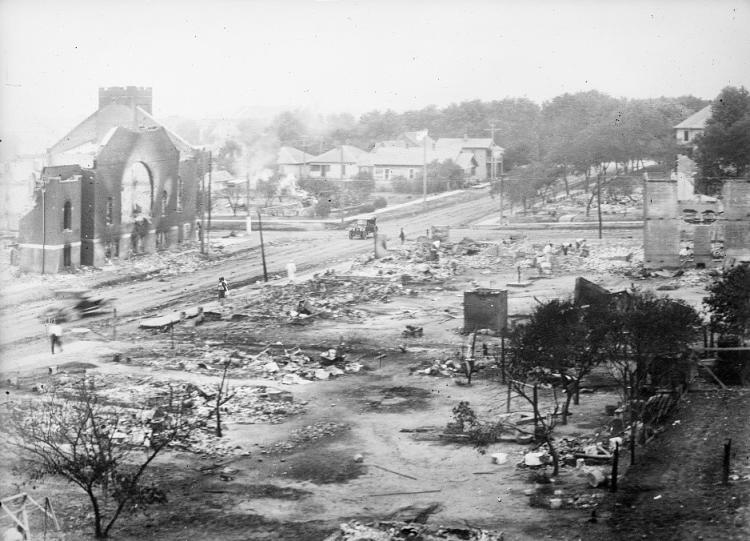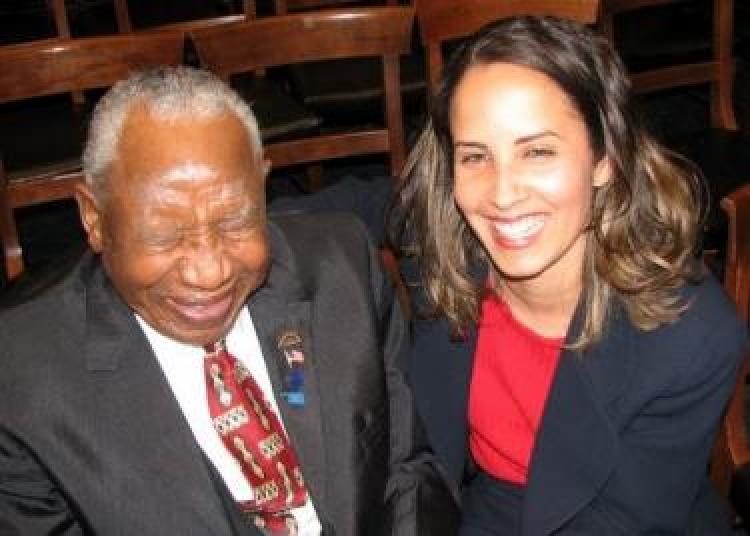100 years later: Colorado Law professor reflects on Tulsa Race Massacre

Tulsa's Greenwood district after the Tulsa Race Massacre (Photo: American Red Cross. Prints and Photographs Division.)
It was one of the worst massacres in American history, yet, for many Americans, the Tulsa Race Massacre is not widely known. From May 31 to June 1, 1921, hundreds of white Tulsans—armed and deputized by the local government—attacked, pillaged and destroyed the thriving Black community of Greenwood, Oklahoma, also known as “Black Wall Street.”
The 18-hour period of violence spawned from an encounter with a Black man, named Dick Rowland, and a white woman in an elevator. But Jim Crow laws, white supremacy and racism all played key roles in the attack that destroyed 35 city blocks, killed hundreds and left thousands homeless. Still, what really happened at the massacre was suppressed for decades, until the Oklahoma Commission to Study the Tulsa Race Riot of 1921 released a bi-partisan report in 2001.
CU Law Professor Suzette Malveaux represented more than 100 survivors pro bono in a 2003 federal lawsuit against the state of Oklahoma. The case was dismissed because of a two-year statute of limitations, but Malveaux and her team advocated to suspend the statute for several more years. They sought relief not only in U.S. courts, but also in international courts and before Congress. Their efforts were unsuccessful, however, their fight for justice continues.
Malveaux spoke with CU Boulder Today about her experience working with massacre survivors, why it took so long for them to seek justice and their continued fight.
What inspired you to serve as counsel for survivors in Alexander v. State of Oklahoma more than 80 years after the massacre occurred?

Malveaux with her client, then-104-year-old Tulsa survivor Otis Clark. (Courtesy Suzette Malveaux)
In some ways my involvement was really fortuitous. I was working at a civil rights law firm, Cohen Milstein, and three of us had started a civil rights employment discrimination practice group there. Myself and Eric Miller (a current colleague in academia) actually drafted the complaint for the lawsuit that eventually got filed. We were baby lawyers at the time and in many ways we were breaking new ground and really trying the best we could to get relief for survivors of the Tulsa Race Massacre. At the time, there were over 100 survivors. Now, there are three that we know of.
It was a labor of love because it was pro bono for six years, so we did not get paid, but it was one of the most important cases I have ever worked on in my career.
How did the lawsuit come about?
We brought the constitutional law claims in federal court on February 23, 2003, two years to the day after a report was published by the Oklahoma Commission which gathered testimony––from archivists and archaeologists and lawyers to hundreds of survivors and witnesses. The Commission’s report was the result of a four-year investigation that proved that the government armed, deputized, authorized and commanded a white mob to attack, kill and destroy the entire Black community of Greenwood in 1921. The 20,000-page report gave the survivors the kind of ammunition that they needed to actually bring a constitutional lawsuit against the government for violation of their equal protection and due process rights under the 14th Amendment.
The history of the massacre remained dormant for decades. Why?
Immediately after the massacre, the event was characterized by white newspapers and the local government as a “race riot” and the Black community was blamed for what happened. There has never been a single prosecution. There was nothing in the history books. Additionally, characterizing the massacre as a “riot” denied people the ability to make insurance claims, while zoning laws, redlining and governmental policies made it difficult for people to rebuild.
I do think the amount of time that had transpired enabled people to come forward who were traumatized, and it did give people more courage. But I think there was also a lot of shame and fear on the part of African Americans who maybe didn’t want to pass along this sort of nightmare to their children and didn’t want them to relive that, so they did their best to protect their children.
How has this event influenced the modern-day civil rights movement?
I think we have some real work to do to understand how something in the past impacts people today. There is a racial reckoning and an awakening that is so important today and we have to keep talking about it. We think about the race massacre that occurred––the trauma and the damage that has been done––but it’s been damaging over generations as well, especially when we think about what could have been and how wonderful it could have been if that wealth from one generation was transferred to the next. This is what is so painful for African Americans.
The average white family has 10 times more net wealth than the average Black family in this country, largely because post-reconstruction former slaves were not allowed to succeed. At every turn they fought and clawed, and built this beautiful community of Greenwood in large measure because they were excluded from participating in the mainstream Tulsa economy and community. Greenwood came out of slavery, was built from scratch with beautiful homes, churches, banks and libraries and was incredibly successful. I can only imagine if those people were able to transfer their generational wealth: we wouldn’t have the kinds of racial disparities that we do today when it comes to health, housing, jobs, voting rights and education––all the markers we think about when it comes to living the American dream.
We need to ground ourselves again in what is factual and what is true because you cannot have healing until there is acknowledgment. And it's only then that you can move toward reconciliation, reconstruction or even forgiveness.
Survivors who were children during the massacre recently filed a new lawsuit seeking restitution from the city of Tulsa: Why is this fight still important today?
It can send a message that we as a nation are better than this and we are not going to let the government get away with the murder of American citizens on American soil. We’re evolving and we are going to respect and honor and value the lives of Black people in this country. And my hat’s off to the survivors, to be 107 years old, to get on a plane and travel all day to testify before Congress and tell her story for the first time. I think we need to send the message loud and clear that their voices matter, and that there’s accountability, that the legal system works.
What advice would you give someone aspiring to work in Civil Rights Law?
As advocates, as lawyers, as lawmakers and as politicians, we need to do more listening and come with a humble spirit to make sure the work we are doing is really for the survivors’ benefit. I love the story and the image of the Black lawyer B.C. Franklin who, just days after the massacre, went out to practice law in a tent to bring relief in the form of insurance claims to his community, even with his life on the line. I feel very inspired by the people that have come before me; I don't feel alone and that’s important. It takes community, support and courage.


